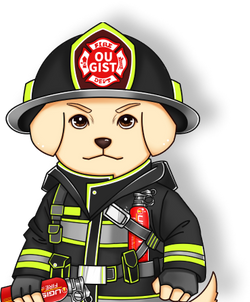A fire extinguisher is a vital tool in the fight against fires, offering a means to swiftly and effectively suppress flames before they escalate. To comprehend the mechanics behind a fire extinguisher's efficacy, it's essential to grasp what it discharges. In this blog post, we'll delve into the components of a fire extinguisher discharge and how they work together to combat fires.

The Discharge Agents: Fire extinguishers employ different substances to combat specific types of fires. The discharge agent is the active ingredient that extinguishes the flames by disrupting the fire triangle - fuel, heat, and oxygen.

-
Water: Water is commonly used to douse fires fueled by ordinary combustibles like wood, paper, and cloth. It cools the fire, reducing the temperature below the ignition point and suffocating it by removing heat.
-
Foam: Foam extinguishers are effective against flammable liquid fires (Class B) and some solid combustibles. The foam blankets the fire, preventing the release of flammable vapors and cooling the flames.
-
Dry Chemicals: Dry chemical extinguishers come in different types, each designed for specific fire classes. These chemicals interrupt the chemical reaction of the fire. Examples include:
- ABC Powder: Suitable for Class A, B, and C fires. The powder forms a barrier that inhibits combustion.
- BC Powder: Effective against flammable liquid and electrical fires (Class B and C).
- Purple K Powder: Used for flammable liquid fires and is often found in industrial settings.
-
Carbon Dioxide (CO2): CO2 extinguishers suffocate fires by displacing oxygen, effectively removing one leg of the fire triangle. They are suitable for Class B and C fires, as well as electrical fires.
-
Wet Chemicals: Specifically designed for cooking oil fires (Class K), wet chemical extinguishers create a cooling and smothering effect, preventing re-ignition.

The Discharge Mechanism: A fire extinguisher discharge is initiated by pulling the safety pin and squeezing the handle. This action punctures a seal, allowing the discharge agent to be expelled under pressure. The agent is released through a nozzle or hose, forming a directed stream or spray that blankets the fire.
Choosing the Right Fire Extinguisher: Selecting the appropriate fire extinguisher for your environment is crucial for effective fire suppression. Consider the fire classes relevant to your setting and potential risks:
- Class A: Ordinary combustibles (wood, paper, cloth)
- Class B: Flammable liquids (oil, gasoline, grease)
- Class C: Electrical fires
- Class D: Combustible metals (magnesium, titanium)
- Class K: Cooking oil fires
Maintenance and Training: Regular maintenance ensures that your fire extinguisher remains operational. Inspections, pressure checks, and recharging (if discharged or partially used) are essential to guarantee its reliability.
Furthermore, training in proper fire extinguisher use is invaluable. Knowing how to approach a fire, aim the extinguisher, and sweep the nozzle across the base of the flames maximizes its effectiveness.
Conclusion: Understanding what a fire extinguisher discharges is crucial for making informed decisions during emergencies. Each discharge agent has unique properties that cater to specific fire classes, allowing you to respond effectively to diverse fire scenarios. By familiarizing yourself with different extinguisher types, maintaining your equipment, and acquiring proper training, you equip yourself with the knowledge and tools needed to tackle fires and protect lives and property. Remember, a well-maintained and properly used fire extinguisher can be a lifesaver in critical moments.


